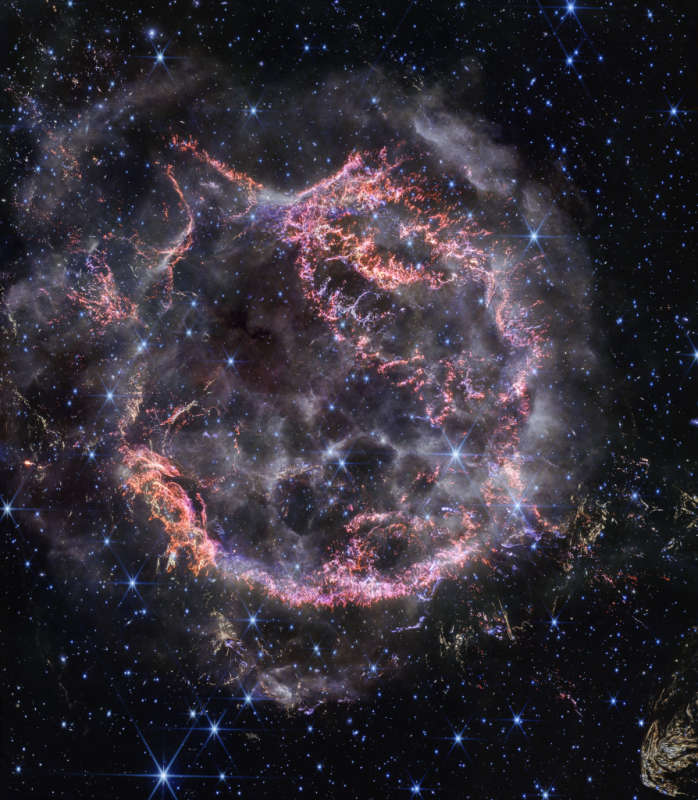
|
Credit & Copyright: NASA,
ESA,
CSA,
STScI;
D. Milisavljevic (Purdue University),
T. Temim (Princeton University),
I. De Looze (University of Gent)
Explanation:
Massive stars
in our Milky Way Galaxy live spectacular lives.
Collapsing from vast cosmic clouds, their nuclear furnaces
ignite and create heavy elements in their cores.
After only a few million years for the most massive stars, the
enriched material is blasted
back into interstellar space where star formation can begin anew.
The expanding debris cloud known as Cassiopeia A is an example
of this final phase of the
stellar life cycle.
Light from the supernova explosion that created this remnant
would have been first
seen in planet Earth's sky
about 350 years ago,
although it took that light 11,000 years to reach us.
This
sharp NIRCam image
from the James Webb Space Telescope
shows the still hot filaments and knots in the supernova remnant.
The whitish, smoke-like outer shell of the expanding blast wave
is about 20 light-years across, while the
bright speck
near center is a neutron star,
the incredibly dense, collapsed remains of the massive stellar core.
Light echoes from the massive star's cataclysmic explosion are also
identified
in Webb's detailed image
of supernova remnant Cassiopeia A.
Tonight watch:
The
Geminids
|
January February March April May June July August September October November December |
| ||||||||||||||||||||||||||||||||||||||||||||||||
NASA Web Site Statements, Warnings, and Disclaimers
NASA Official: Jay Norris. Specific rights apply.
A service of: LHEA at NASA / GSFC
& Michigan Tech. U.
Based on Astronomy Picture
Of the Day
Publications with keywords: Cas A - supernova remnant
Publications with words: Cas A - supernova remnant
See also:
- APOD: 2024 April 16 Á Filaments of the Vela Supernova Remnant
- APOD: 2024 April 3 Á Unusual Nebula Pa 30
- APOD: 2024 March 25 Á Sonified: The Jellyfish Nebula Supernova Remnant
- APOD: 2024 February 27 Á Supernova Remnant Simeis 147
- The Pencil Nebula Supernova Shock Wave
- APOD: 2023 December 26 Á IC 443: The Jellyfish Nebula
- APOD: 2023 November 21 Á Flemings Triangular Wisp
